|
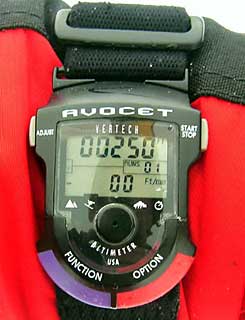 A Ski Watch for All Occasions A Ski Watch for All Occasions
by Emilio
Trampuz
Sept. 2014
It would be nice to have a universal
watch that has all the outdoors capabilities (such as compass and altimeter)
but is also elegant enough to be worn as a regular everyday watch. A watch
you can take everywhere, both diving and skiing, as well as to a business
meeting.
I wrote a first version of this article in
2007, and now, seven years later, I am still looking for the perfect
indoors/outdoors watch. Some watches come
tantalizingly close, but every watch has some major flaw, either
not being waterproof enough, or using up batteries too quickly, or lacking ski-related functions.
Above all, I want my perfect watch to be able
to pass the Robinson Crusoe test: 5 years on a desert island, after
first surviving the shipwreck and the swim ashore, surviving water, salt,
sand and dust. Most watches aren't waterproof enough, and those
that are will become useless when the battery dies after a year or two.
My old Avocet Vertech watch (shown
above) had all the ski-related functions I needed, it was user friendly and
accurate. Unfortunately, it's battery lasted only 2 years, and I had
to mail the watch to a service center for battery replacement. The new Avocet
Vertech II has a
longer-lasting battery, extended to 4 years, thanks to the watch going to sleep when not needed. This is still the most skier-friendly watch.
But it is not meant to be worn on your wrist as an
everyday watch, it is not very water-proof. It will resist a
bit of rain and snow, but don't go swimming with it.
Most watches fail in their water
resistance.
30 or 50 meters (3 - 5 Atmospheres) will
survive some rain, but donít go swimming with it.
100 meters is OK for swimming, but donít
splash too hard, and donít dive from a high place.
200 meters is the minimum to be sure that you
can take it with you anywhere. Weíll never dive that deep, but when you swim
and splash around, the pressure on the watch is a lot higher than if the
watch is just sitting at rest at a certain depth.
Here are the 10 features we'd like to
see in a real skierís watch:
1. Timepiece (to simply tell time), and
Chronograph (stopwatch, count-down timer, and alarm).
2. Altimeter (to tell altitude, number of runs, total
vertical skied) and Barometer (air pressure, weather).
3. Compass, to tell us where north is.
4. Tough - to be able to withstand
vibrations, bumps, and sudden deceleration (falling to the ground).
5. Waterproof - preferably at least to a
depth of 200 meters (600 feet) or 20 Atmospheres.
6. Ski functions - count the number of
runs (hills), total daily vertical, the annual total, and vertical speed.
7. Analog hands -which are much easier
to see in low light than most digital displays.
8. Digital display - the only way to
accurately display altitude, number of runs, and other data.
9. Solar powered, so you donít have to change batteries every few
years, when you least expect it!
10. Affordable - Expect to pay over
$100, probably even $200 - $400. But $1,000 is too expensive.
Does a complete watch exist, with all 10 out
of 10 features? Well, almost! All these features are already
available, but not yet in one single watch. Who will be the first to come up
with a complete watch? In the meantime, let's rate the existing watches on a
scale from 1 - 10, based simply on how many of the above features they have.
Beware! Some older watches have
altimeters that can tell you the altitude, but do not provide cumulative
totals or the number of runs. Some watches, like the Casio Pathfinder PAG80,
claim they keep track of cumulative ascent or descent, but what they mean is
that you have to start a new "session" by clicking a button every time you
begin another ascent or descent. That's a cumulative total suitable for
climbers, not skiers.
There have been some significant improvements
and changes since 2007, when a first version of this article was written.
For example:
1. More altimeter watches now include a
compass. The generic name for these is "ABC watches", since they have
an Altimeter, Barometer, and Compass. By the way, we count altimeter and
barometer as one in the scoring below, since they both rely on the same
sensor: the air pressure sensor. Every altimeter watch also has a barometer.
2. For years, only Casio watches were solar
powered. Now Tissot and a few others offer solar power, but only Tissot
and Casio offer solar power in an ABC watch.
3. Analog, mechanical hands are now
available in combination with a digital display, in both Casio and Tissot
watches. A digital display is needed to show all the numeric data. But
analog, mechanical hands are easier to read to tell the time, especially in
low light, and especially for the not-so-young whose eyesight isn't as sharp
as it used to be. It's easy to tell the time just by the position of the
hands, even if they might appear a bit blurry. By contrast, if your eyesight
isn't sharp, it might be hard to distinguish between a digital 3, 5 and 8.
Some Casio and Suunto watches
and the Tissot T-Touch come close to perfection, but each misses some important
feature.
See the pros and cons below. We rate them here by simply adding up the
features from the list of 10 above.
Write to the manufacturers and let them know
that millions of skiers are just waiting for a watch with all of these
features.
|
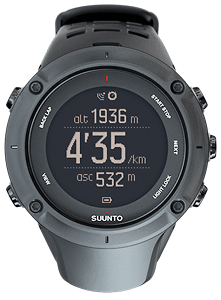
Suunto Ambit 3
Score: 5
(of 10) $400 - $600
A GPS watch, computer
connectivity.
PROs:
Lots of functions, including a heart rate monitor. Data can be uploaded
to a computer wirelessly. It measures vertical speed based on GPS.
CONs: Water resistance only to 50 meters. Battery last a maximum
of 14 days, or only 1 or 2 days if GPS is active. Altimeter relies
exclusively on GPS, not air pressure. It has functions specific to
running, cycling, and swimming, but not skiing. |
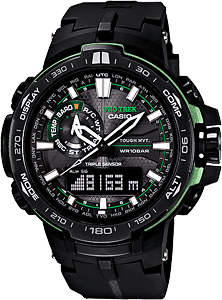
Casio ProTrek PRW6000
Score: 8
(of 10) $545
The latest
Casio ProTrek, Analog/digital.
PROs: Solar
powered, as all ProTreks. Has a Compass, Altimeter, Thermometer. Analog hands + digital
display. Second hand doubles as a compass when needed. Compass improved
over previous models. Solar battery lasts up to 6 months in total
darkness, without recharging.
CONs: Mediocre water
resistance (100m). No skier specific functions. Doesn't count the number
of runs. Taking measurements at 2 minute intervals is too slow. Expensive. |
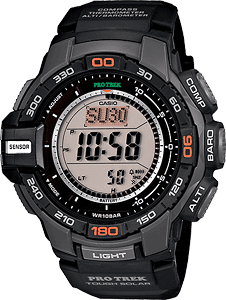
Casio ProTrek PRG270
Score: 8
(of 10) $120 - $130
Lots
of features, but not for skiers.
PROs: Solar
powered, as all ProTreks. Has a Compass, Altimeter, Thermometer. It has the smaller,
faster more accurate triple sensor (3rd generation).
CONs: Mediocre water
resistance (100m). No skier specific functions. Doesn't count the number
of runs. Measurement interval of once every 2 minutes is too slow. Loses
a point for not having analog hands (which are easier to read), but gains a point for being more affordable than the the
PRW6000.
The newer PRG280 watch improves water
resistance to 200 m, and adds analog hands, but it has no alitmeter at
all, and therefore absolutely no ski functions. |
|
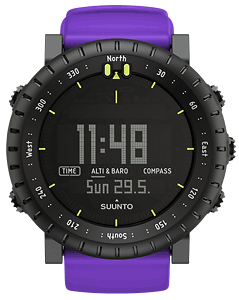
Suunto Core
Score: 6
(of 10) $210
Has skiers' essentials.
More affordable than the
Ambit.
PROs: Has
cumulative totals. Has a Compass and
Altimeter. You can take it down to a 10 meter depth, good enough
for snorkeling.
CONs: Water resistant to only 30 meters (the worst
of the bunch). Battery lasts only a year. Display is dark, hard to read.
The watch band breaks frequently and is expensive to replace. |
The
Perfect watch
A Casio
with ski functions, or a
Suunto
with solar power & analog hands
Who will
be the first?
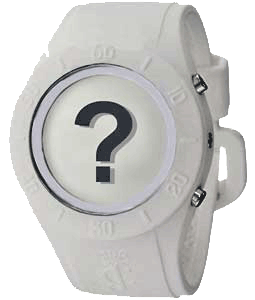
Yet to come
$300 or less
Solar
Altimeter, Barometer,
Compass
Ski functions
Analog hands + Digital
display
Waterproof to 300
meters. |
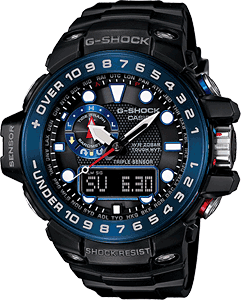
Casio G-Shock GWN1000B
Gulfmaster
Score: 8
(of 10) $430 - $500
Sturdy,
analog/digital, but no ski features.
PROs:
Shock-resistant, water resistant to 200 meters. Solar powered, recharged
by any light source, works for 6 months in total darkness. Has a Compass, Altimeter, and Thermometer.
CONs: No ski features in any G-shock models, other than a slow
altimeter that measures altitude at only 2 minute intervals. You can do
a lot of skiing and then riding a chairlift in 2 minutes. Some of your
altitude change will not be recorded. Expensive. |
|
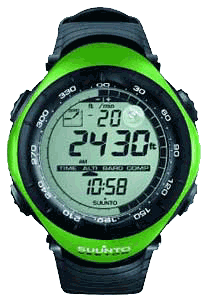
Suunto Vector
Score: 7
(of 10) $140 - $199
This is the watch that
made Suunto popular.
PROs:
Has altimeter (air pressure based), compass, and more.
CONs: Water resistant to only 30 meters (the worst of the bunch).
People report water leaks in a swimming pool. Battery lasts only a year.
The watch band breaks frequently and is expensive to replace. |

Tissot T-Touch Solar
Score: 7
(of 10) $720 -
$1,200
Solar Swiss watch.
PROs:
Touch screen, analog/digital display, Solar powered, recharged by any
light source,
CONs:
Mediocre water resistance (100m). Measures
altitude for a maximum of 10 hours, and then stops automatically. Takes
altitude measurements once every 5 minutes, worse than Casio watches.
Tissot has not published information on how long the battery will last
without recharging.
This watch is expensive. |
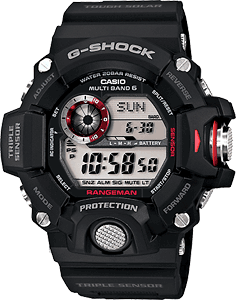
Casio G-Shock GW9400-1 Rangeman
Score: 8
(of 10) $240 -
$300
Sturdy,
but no ski features.
PROs:
Shock-resistant, mud resistant, water resistant to 200 meters. Solar powered, recharged
by any light source, works for 6 months in total darkness.
CONs: No ski features in any G-shock models, other than a slow
altimeter that measures altitude at only 2 minute intervals. You can do
a lot of skiing and then riding a chairlift in 2 minutes. Some of your
altitude change will not be recorded. |
|
|
|
|
Honorable Mentions
|
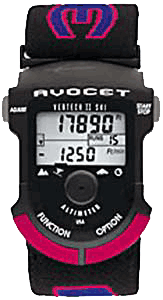
Avocet Vertech II
Score: 5
(of 10) $100 - $150
Specialized ski watch.
Other watch makers
should learn about ski functions from this watch.
PROs:
Good set of ski features. It counts the number of runs as well as the
total accumulated vertical. Battery life improved to 4 years (thanks to
a sleep mode).
CONs: Not waterproof. Only to 10 feet (3 meters). Can only
withstand some rain and snow, but not a swimming pool. No compass. Not
suitable for everyday use.
This is a specialized tool just for skiing.
It works best as a second watch. Has to be mailed in for battery
replacement.
It might be hard to find a new one of these watches to
purchase. |
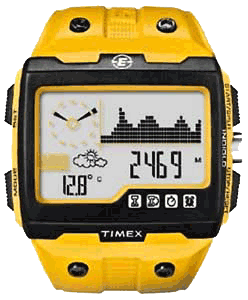
Timex Expedition WS4
Score: 5
(of 10) $130 - $160
A specialized
watch, but not for skiers.
PROs:
Has altimeter, compass and thermometer. Accurate weather and altitude
measurements.
CONs: Probably a bit too geeky to wear as an everyday watch.
Uses a lithium-ion battery. This watch is huge: 6 inches x 6 inches.
Water resistant to 50 meters.
This Timex watch has a completely different definition of
"accumulated altitude". According to the manual, if you climb 400
meters and then descend 400 meters, your accumulated altitude is zero!
So this watch will not add up your accumulated vertical skied. It just
shows you the altitude difference from your starting point. |
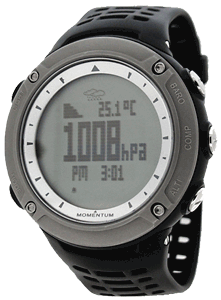
St. Moritz Momentum VS3
Score: 6
(of 10) $195
Good all-around watch.
Small, stylish,
functional, made in Canada.
PROs:
The display is a high resolution dot-matrix screen. Has altimeter,
compass and thermometer,
CONs: Water resistance only 50 meters (5 atmospheres). Battery
lasts between 1 year and 18 months. Altimeter measurements are taken
only once every 10 minutes (the worst of the bunch). Altimeter records
data for only 5 hours (not even a full ski day). Changing the mode from
altimeter to compass or to time will stop the altimeter recording, just
like on Casio watches. This is terrible! It means that if you want
to measure your accumulated vertical, you can't use any of the other
functions at the same time. |
NOTE ABOUT GPS
WATCHES: All GPS watches consume so much power that their battery
lasts only a day, or sometimes a maximum of 2 days. In most cases, consider
yourself lucky if you get one whole day without recharging. The
Garmin Fenix is a good GPS watch, if you can live with the short battery
life and poor water resistance (50 meters). But keep in mind that it
is easy to lose the GPS signal in the mountains, forests, and canyons.
NOTE ABOUT
SMART WATCHES FROM APPLE, SAMSUNG, etc. Watches such as the i-Watch
or the more established Samsung Gear might some day rival the watches listed here, but that
day is still far in the future. They can run various apps (if you are
satisfied with the tiny screen). But they rapidly consume batteries (lasting
maybe 2 - 3 days), and have poor water resistance (3 feet or 1 meter). For
now, they are not really in the same category with the outdoors watches
listed here. They are the farthest from passing the Robinson Crusoe test.
They probably wouldn't even last long enough for a Robinson Crusoe weekend!
And almost everything these smart watches can do, your smart phone can do
better.
NOTE ABOUT CASIO: Casio watches
have the highest scores, offering most of the desired functions for a
relatively reasonable price. Most Casio watches will pass the Robinson
Crusoe test. Casio is the only watch manufacturer
offering solar power in most of their watches. Only two other watch makers
offer solar power: Seiko (with no altimeter or any other ski
functions) and Tissot (which is very expensive).
Pro-Trek watches (formerly known as
Pathfinder watches) are all water resistant to 100 meters.
G-Shock watches are almost all
resistant to 200 meters. That makes the G-Shock Gulfmaster one of the best
for now.
The main fault in Casio watches is that
none of them have skier-specific functions. They don't count
your number of runs. They do accumulate your total vertical skied, but
there is no start/stop button. If you switch from the Altimeter mode to the
Compass mode, the watch stops recording altitude. Changing the mode
acts as a stop button. That's not good. The altimeter should have
a start and a stop button. The watch should continue recording altitude
changes and measure cumulative vertical, even if you change modes during the
day, continuing to record altitude until you
hit the stop button.
Also, accumulating vertical currently stops
automatically after about 10 hours, which might be just enough for most
recreational skiers, but it is not enough for an all-night vertical
challenge such as Hope on the Slopes.
The altimeter's measurement interval of 2
minutes is too slow. Yes, Casio does offer a shorter 5 second
interval, but that only lasts for an hour, and then it reverts to the slower
2-minute pace.
If Casio would just tweak it's software to provide
skier-specific functions, and shorten the measurements interval to at least
30 seconds, and allow continuous recording of altitude changes regardless of
which mode it is in until the stop button is pressed, Casio could
easily become the best ski watch in the world.
NOTE ABOUT SUUNTO: Most Suunto watches have the following
problems:
1. Batteries need to be replaced frequently.
2. Replacement wrist bands for Suunto watches
are expensive.
3. Not a single Suunto watch offers analog
hands to display time. It's all digital, and screen visibility isn't always
good.
4. The alarm on Suunto watches may not be loud
enough to wake you. This may have been done on purpose. A weaker alarm means
the battery will last longer.
5. Relatively low water resistance; only down
to 30 or
50 meters (3 or 5 atmospheres).
NOTE ABOUT AVOCET VERTECH: This watch
has all the skier specific functions we need. If other manufacturers don't
know what skier functions we want from a watch, they should take a good look
at the Avocet Vertech watch and learn from it. It counts the number of
runs (hills), it accumulates your vertical all day, and there is also an
additional counter that accumulates vertical all season (or all week, or
until you reset it back to zero). It's a pity that nobody
seems to be developing and improving this watch. It would be great if the
Avocet Vertech could be made to look like a regular watch, make it more
waterproof, add a compass, and make it solar powered.
NOTE ABOUT HIGHGEAR: Highgear is not
making watches any more. Some are probably still available on the market,
but there will be no future development, and support is relatively minimal.
Highgear Altis has an altimeter, barometer, and compass. But it
is water resistant only to 50 meters (5 atmospheres), and it is battery
operated (no solar).
WHAT TO DO
If you want that perfect ski watch, send your
desired list of features to both Suunto and Casio. Ask them to forward your
email/letter to those in charge of designing new watches. Compliment Casio
on their solar powered watches, but ask them why they are so completely
ignoring skiers and snowboarders. There are more skiers and
snowboarders in the world than there are mountain climbers.
Tell Casio we need the altitude measurements to be taken at
least every 30 seconds all day, until the stop button is pressed. Currently, all Casio watches take
measurements only once every 2 minutes. In just one minute, you can ski
down 500 vertical feet, then get on a chairlift and be taken up a few
hundred feet in the next minute, and the watch might not record any of that
at all, or just a small fraction of it.
Tell Suunto weíd like solar powered watches, because Suunto
watches are too battery hungry. Also, Suunto needs to improve the water
resistance of their watches. And please add analog hands to tell time.
Tell both of them we need at least 200 meters waterproof watch, or
300 meters would be even better. If we are going to buy an expensive
watch, we would like it to be truly waterproof.
If you write, it is best to send your message
to the manufacturer's headquarters, in their home country (Japan, or
Finland). Their U.S. offices are mainly for local sales and marketing
people, who seem to be unable to forward your feedback letters to those who
design the watches. So, it's best to contact the watch designers directly.
|



